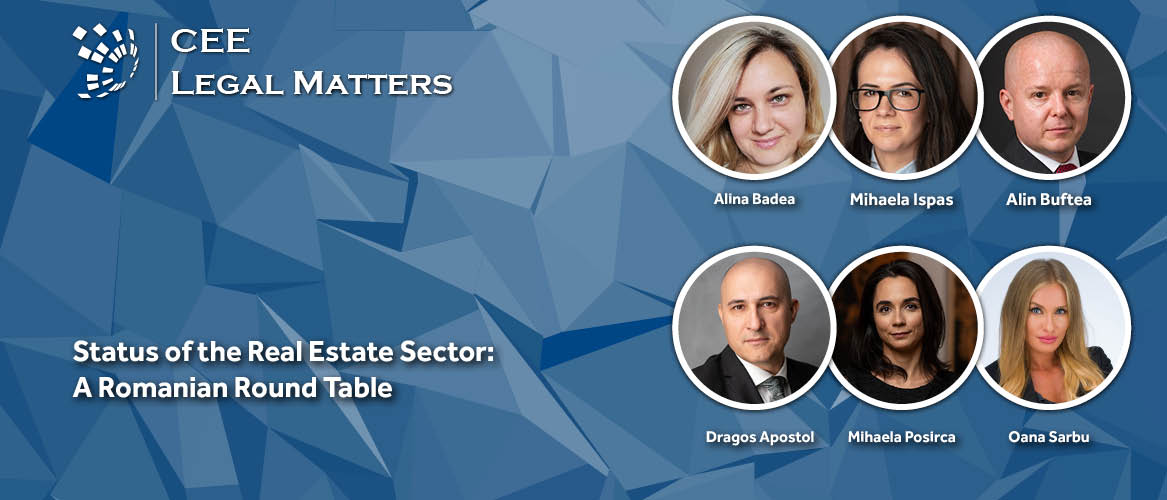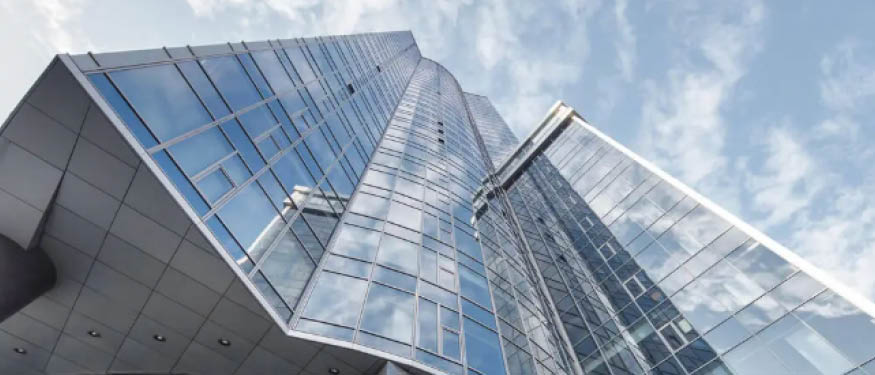On January 18, six leading real estate lawyers in Romania sat down for a virtual round table moderated by CEE Legal Matters Managing Editor Radu Cotarcea. The conversation focused on the current state of affairs in the real estate sector, looking at who the main players are, the hottest assets, deal-making trends in the sector, and more.
Round table participants:
– Alin Buftea, Partner and Head of Real Estate, DLA Piper Romania
– Alina Badea, Senior Associate, MPR Partners
– Dragos Apostol, Partner, Tuca Zbarcea & Asociatii
– Mihaela Ispas, Counsel, Filip & Company
– Mihaela Posirca, Partner, ACT Botezatu Estrade Partners
– Oana Sarbu, Partner, Domokos Partners
You can also listen to the conversation as a podcast below.
CEELM: Let’s look into the assets that everyone is talking about. What are the hottest targets, sectors, and locations – and what do you think is driving that?
Sarbu: The residential and the logistics market definitely registered the best results of 2021 – and will also be the stars in 2022. The pandemic had a positive effect on these two sectors, and we can see an increase in sales and acquisitions of approximately 48% for the residential market. This is the data offered by the top real estate agencies and the National Institute of Statistics.
And while the logistics market has also seen an increase, other sectors, such as office and retail, have seen a pandemic-induced decrease. Markets have transferred online, more or less.
CEELM: Residential is an intriguing sector, especially due to the pandemic in which one would expect an economic crunch and not much disposable income. What is driving the residential sector?
Apostol: Before speaking about the residential segment, I can confirm that logistics was indeed a very hot trend in 2021 and this is likely to continue, probably in the context of the pandemic where online sales have increased. I was reading a market survey and it says that the volume of online transactions increased by 400%, compared to 2015. So, there is a big opportunity to continue investing in logistics.
As far as the residential segment is concerned, I am not that optimistic. According to market surveys, prices seem to have reached a very high level. Some important voices are warning that the residential market could face a crash, which, of course, nobody wants, but it could happen. The residential sector is under question in my opinion.
CEELM: We’re seeing a shift in CEE from office spaces, as being quite distressed at the moment, to multi-purpose or purely residential assets. Is it happening in the Romanian market as well?
Posirca: As Dragos said, the prices in residential are quite high – especially due to the construction prices increase. There are, however, changes, as with every market. We are starting to see a change in a market that is traditionally driven to hold residential assets. Romanians always want to own their house. That is changing somewhat – very, very slowly, but still – we’re seeing people who are buying residential for renting, especially assets that are developed as residential. And some small funds are also acquiring apartments for this purpose. This is still a small trend, and we are all concerned about the high prices.
I wanted to also highlight something about offices. The office sector was highly affected by COVID–19. The reality is a mix of office and home flexibility – nobody knows exactly where it’s going, it still remains a question mark. But office remains one of the most active segments, at least in terms of investments and acquisitions, especially considering the liquidity of the market but there are several buyers in this market. So, the office sector is still the main sector, in terms of investments, of 2021, with the biggest tickets as well.
Ispas: In relation to residential, indeed there was growth in the last year. During the lockdown, there was a lot of uncertainty with respect to the residential market, but – considering people’s need for working from home – a need for domestic office space has emerged. People needed to reconfigure their homes and most of them upgraded – from two bedrooms to three, and so on.
Also, in this respect, a reduced VAT of 5%, which was announced one year ago, was an incentive. Many people who contracted promissory agreements for homes in newly developed buildings got a subsidy. Still, there are obstacles, making future developments far from certain, like the prices of raw materials and the labor shortage on the construction market, which is a recent challenge and will develop in the following period. It remains to be seen how all these factors develop in 2022.
Badea: In terms of fervid businesses on the real estate market, I agree with Dragos about the logistics sector.
As lawyers, we are usually looking into our clients’ activity, not necessarily into the news and biased statistics on the markets. In terms of our clients’ interests, for residential clients, we noticed an interest to relocate to the outskirts of the city, because of the lockdown, generally. And that people would rather leave an apartment for a house.
We also noticed, however, the banks’ cautious approach to financing residential acquisitions, mostly due to the lockdown-induced stay of installments. Clients who had stayed their installments with banks were generally not favored for future financing. So, if they did not have their own funding, it was rather difficult to finance acquisitions.
In terms of logistics, we noticed some fervor on the market due to the increase of online retail and overall activities. There was indeed a decrease in interest in commercial business premises. And, in the office market, we saw a need for lower rents and for offices allowing for lower rates on expenses and rents, including the renegotiation of current agreements.
Buftea: Residential is one of the hottest sectors. I hope that it is sustainable. I see it as a little bit problematic because we don’t have a private rental sector in Romania, as most of the investors bought and wanted to become homeowners.
Yields are calculated not based on the produced income, but rather on the capital appreciation of the assets, based on valuation reports. We are lacking institutional investors and there is not a single big institutional player who amassed a sizeable portfolio of thousands of apartments for rent. Sooner or later, we will probably see a movement in this respect in the market.
Sarbu: About the residential market – of course, construction will cost a little bit more than before, but, still, there is no comparison with 2008, when prices were much higher. Still, the average income is higher now than it was in 2008 – meaning that the entire price of an apartment could be covered by an individual in, say, ten years. In 2008, this was 25 or even 30 years, because the income was much lower. I would still say that investing in the residential market is a good deal, even in the long term.
CEELM: Since we started talking about the targets, why don’t we look into who is actually buying? Which are the main investors that are floating around the market, who is making the biggest splashes these days?
Buftea: I think there are different types of investors, depending on the profile of the sector. As I mentioned, in terms of residential, we are still waiting for big players to amass portfolios. In the office sector, we have new players exploring entry into the Romanian market, with fresh money, mostly private equity funds.
From what we have seen recently, there are not that many good projects available, in terms of the ticket size. At each level – the good projects are either under development, or there are not that many available. Hopefully, this will shift soon. Compared to the rest of CEE, I think that the Romanian real estate market is still underdeveloped, way below Poland, Hungary, or the Czech Republic, for example. We still have a way to go.
It is good to have traditional investors in Romania, of course, they do have a good track record, but we also need to have the big guys incoming, like German investor funds.
Sarbu: Mostly, the investors are investment funds. They are strong participants in the real estate markets. Also, local companies that start to invest in real estate – Romanian companies, not only foreign companies and foreign investment funds. We see this due to the maturity of the local market and local companies which are very strong.
Posirca: To pick up on Alin mentioning the ticket size – indeed, the ticket size in the Romanian market has been quite low in the first months of 2021, even lower than in 2020. This has an impact on financing – we have seen international banks interested in financing real estate acquisitions on our market, but which are looking for big tickets of more than EUR 100 million. That is still something that affects the markets.
We’re happy to see that the end of 2021 was very, very intense in terms of deals closing, including quite a high number above this EUR 100 million benchmark.
In terms of investors’ nationality, I believe that the Austrians remain the most active, representing more than one-third of investments. But, as Oana said, it is very good to see during the past few years that Romanian investors are being more and more active on the market. Traditionally, they were active on the development side, but they are, over the past few years, increasing their investments in logistics and offices – for example with One United Properties.
CEELM: Based on the general conversation so far and the lack of big-ticket deals, I get the impression that general levels of PE are relatively lackluster. Would that be an accurate impression?
Apostol: Romania still has a lot of room to grow in terms of real estate investments. Logistics is a hot sector now, but also quite sustainable in the next few years. Speaking of comparisons, we have to go up to some 10 million square meters just to match the volume of logistic space per capita in Poland. This could give you a better picture of how big this growth opportunity is.
Unlike the residential segment which is very much dependent on the end purchasers’ income – and where prices are high and not very sustainable – in logistics, the demand is here, and it will definitely increase over the next years. We see big changes in consumption practices. Consumer habits have changed over the past two years, it is quite obvious.
Speaking of investors, I may be subjective because most of my 2021 projects were logistics-focused, but I do see a big appetite to develop a lot of projects that are over 100,000 square meters. The hottest areas are around Bucharest, but not only there – the Braila region is worth mentioning, as is the entire North-West part of the country.
Logistics is a sector that will most likely see solid growth in the next couple of years.
Ispas: Just a brief comment on PE activity: we’ve seen that Romania has become more and more appealing to investment funds. There are those that seek distressed assets, yield producing assets… it depends on their interest, the type of the project, and the structure of the project.
There has been a lot of interest in residential too, some investment funds are looking around. It is good to see that Romania is more and more attractive for investment funds.
Sarbu: Indeed, Romania is becoming more interesting, especially looking back over the last ten years. A lot of foreign companies are investing and developing in Romania. Investments mainly come from their own equity or from bank financing. Levels of obtaining this financing depend on the level of experience, background, and so on. And the passage of time just improves this and grows the appeal.
CEELM: We’ve touched on developers briefly but who are the largest developers in the market currently and what are they focusing on the most? Residential and logistics mostly, or are there those that seek to get ahead of the curve and look at other types of assets at the moment?
Apostol: At the moment the largest investor is CTP by far. We’ve had the chance to assist Zacaria last year – a very active logistics developer – on the sale of their portfolio to CTP. Also, another important player is Element Industrial, and Ionut Dumitrescu has huge experience in this sector.
Again, we do see interest in office buildings from investment funds, for instance from Hungary. It is a bit of a paradox: in 2021, due to the pandemic, there was a decrease in the need for new premises – which is quite true, but looking at the actual transactions, there was an increase in the demand for office buildings. Those office buildings which have a good quality of development, that have very strong tenants, long-term leases, and types of tenants that are not affected by the pandemic – these buildings continue to be really attractive for purchasers despite the fact that sometimes the need for new premises is actually decreasing.
CEELM: To interrupt real quick, is the belief that the current lessees are not affected by the pandemic?
Apostol: It depends, because some of the lessees were not very much affected in terms of revenues, so they continued to pay their rents uninterruptedly. However, others were severely affected and were forced to renegotiate their lease terms and even to significantly reduce their leased area.
Still, it is a changing market, one cannot say that the office market is doomed or that it will continue to be a successful one. I see a tendency in both directions.
If we get back to the pre-pandemic “normal,” the office buildings sector should thrive again. I believe this will happen.
On the other hand, landlords are more flexible and attempt to renegotiate and rework the contracts – working from home is here to stay, it is clear, so flexibility is a must. Buildings, office buildings with good tenants, and with a good quality of development are still attractive.
Alina: Our clients seem to focus on special purpose buildings – like multi-story car parks. Not necessarily just in Bucharest, but around the country – we have some projects ongoing in the West of the country too.
I agree with Dragos, that office buildings are still of interest, but it is also linked to special purpose buildings which allow for specific building use. Our clients focus, lately, on these types of buildings which have become more interesting.
We should not ignore the fact that the real estate market has other directions – concessions for lands for energy projects, for example. This was our constant activity for the past two years, assisting clients with projects with a real estate component, but related to the energy market. Not to be ignored – the real estate component is expressed in these projects.
In terms of investors, we have PEs but also funding, usually from Spanish banks. We had projects with some Spanish banks and usually external banks, foreign banks.
Buftea: Green energy projects are the most interesting asset class for investors – there has been a lot of activity for the past years in this area. Also, I would like to add that our clients are active in the retail sector, mainly in secondary and tertiary cities throughout Romania. There are also other asset classes that are still so-called “exotic asset classes” such as student housing, data centers, and social housing, that will be developed probably over the upcoming years.
CEELM: We covered the what and the who, let’s take a look at the how. What’s the preference and what would you recommend, given Romanian context – share deals or asset deals and why?
Ispas: On real estate transactions, especially with revenue-producing assets, a share deal is preferable from a cost and tax perspective. But it also depends on the structure of the project. Is there a question of a carve-out of an asset subject to litigation – if yes, then an asset deal is better.
It also depends on the timing of a transaction. An asset deal is faster. Also, there is a trend to do a share deal if the object of the transaction is only land.
CEELM: Why is that?
Ispas: I believe it has to do with the structures proposed by the investors because they want to acquire participation in local Romanian companies.
Posirca: I wanted to highlight something about the speeds of acquisitions. Indeed, asset deals are the fastest, but share deals have been complicated too because of a two-stage process involving LLCs where we had a legal procedure allowing creditors to oppose the sale. That law has changed, and without the oppositions stage, share deals have been executed much faster than in the past.
Also, with other restrictions lifted, you could have an LLC owned by another LLC – which has simplified the acquisition process through share deals.
The operating process is much smoother in terms of transferring patents, licenses, and the like – you take it all as a package.
Also, in some cases, some investors prefer a business transfer agreement, as in an in-between solution.
And, to point out one interesting structure we have seen on the market in the past few years: sale and lease-back projects. We have seen it in both retail and logistics – it is a good structure for both parties because it ensures an asset of good revenues for the buyer and ensures a good source of funding for the development of the seller's core business. It is also interesting to take part in the negotiations on these because it is a partnership, unlike other share deals where we see exits – negotiation and transactions here are much more interesting.
Sarbu: Depending on the client’s desires for what to do with the asset – share or asset deal are both options. If no other liability is desired then an asset deal makes much more sense. However, if a continuation of business is desired then a share deal is better.
If you wish to purchase a power plant, it is preferable to have a share deal in order to have all the permits and other elements in place to continue with the activity momentarily.
However, if the buyer is going for the land only, for an asset deal without any other liabilities – an asset deal is the way to go.
Also, depending on the type of business, tax aspects vary.
CEELM: From a tax perspective, is the share deal always cheaper from a tax perspective?
Alina: When we act for a buyer, we usually recommend a minimum tax audit on the transaction. We do it with our tax department because a share deal is not necessarily cheaper than an asset deal in terms of future possibilities of offsetting VAT.
It might be initially cheaper and easier to finance – because there is no VAT on a share deal – but you cannot offset input and output VAT, so a share deal might not be the most prudent decision.
This decision, on a type of deal, is very, very relative. If you have construction land which triggers acquisition VAT – you would prefer a share deal, due to a lower price and if you have no immediate plans to develop something and, hence, to offset VAT. However, if you have other types of businesses – referring to the asset as a business – this is debatable.
Mihaela mentioned that some investors are looking into business transfers – preferable in some cases because there is no VAT and because it is easier to finance.
Buftea: I concur with what has been said before my colleagues – it is a case-by-case basis analysis. If the deal is an asset or a share deal. We had some clients recently who preferred an asset deal even with a higher tax exposure attached to it and paying the notarial and land book registration taxes.
We’ve seen assets acquired directly as an asset deal because there is another aspect that must be considered: the split between seller and buyer of the LCGT (latent capital gain tax) mainly if the asset is historically registered/acquired at a low value and such evidenced in the company’s books.
Apostol: I fully agree. In my experience, the difference here is always driven by the tax impact of the transaction and the preference of the financing entities. Banks have a big say in how transactions are structured. Investors are always seeking to accommodate the demands of the banks, and the financing sources, and to take them into account.
In terms of transaction structures, we see more and more different structures, like sale and lease-back; or ventures that do not create a legal entity – for example in residential developments, there is a preference for a venture with the owner of the land over a pure sale, with both parties splitting the revenues of the residential project in question.
We have also seen many projects which are built–to–suit, sometimes with a combination of a sale and lease-back.
We have seen a situation where a tenant, who is also a highly experienced developer, wanted to have full control of the development, but once the project was ready – and it was to be a long-term tenancy for about 20 years or so – the project got sold to the financing party and the developer became a long-term tenant.
We have seen this model in use in cases of medical clinic constructions with highly specific outsets – when the future tenant wanted to develop a project to make it highly compliant with specific requirements.
Of course, in terms of minimizing the risk, an asset deal seems to be always preferable, with the tax impact in mind.
I cannot flat-out say that one is better than the other. I think it is always a matter of circumstances.
CEELM: Banks keep on being pointed to, so skipping forward a bit: what are the preferred sources of financing? Banks, bonds issuances, are we looking at capital markets in general?
Apostol: It seems there is a huge amount of money on the market. I was just talking to some lawyers in London, and apparently, 2020/2021 saw a huge increase in transaction volumes. In this period, all investment funds were willing to place their money and there was a big demand for new investment projects.
Investment funds are looking more and more to Romania, they want big tickets, of course, to invest some EUR 200 million at a time, if possible. But, unfortunately, we don’t have too many projects of this size.
In any case, I think it is a combination. The banks are still financing real estate projects and are, traditionally, a major source of finance. We also see smaller players that have enough equity to play with their own money – which is good on the account of higher flexibility, they don’t need to waste time with the banks. Speculative developers with enough equity would also do it this way or would seek a combination of funds in this regard.
So, people don’t follow one recipe, it depends on the context. In any case, investment funds are willing to put big money on the market, that’s my impression.
Sarbu: What I have seen from the clients is that they prefer bank financing usually – some 70%, approximately, of the entire amount, on average. This is applicable to all real estate markets: residential, retail, offices, etc.
As for the other 30%, usually, 10% to 20% comes from PE and another 10% from pre-sales or pre-leases – very important. Developers tend to put the project on the market before they have started construction. Usually, when they get the building permits, they start pre-sales and pre-leases.
CEELM: How are you guys seeing ESG impact the markets of Romania?
Buftea: Recently, I see a vast majority in financing is coming from bank loans. We have also seen alternative financing methods such as sale and leaseback, raising money via capital markets through IPOs or issuing bonds.
I think the banks are very cautious now with respect to ESG. We have seen big PE funds that plan better, their policies prevent them to invest or acquire projects that are not eco-friendly or green and are not even considering such projects that do not have this ESG strong component.
CEELM: Lastly under the ‘how’ – what are the main pitfalls, or, to better frame, what are the main checklist items for new investors to the market?
Ispas: There are a few points on this.
We have seen that increase in raw material prices has had an impact. It was more visible on the residential market because this inflated the final prices. But this is reflected in other sectors as well.
Also, there is the issue of a lack of construction workers. This is also a challenge and we’ve seen that there are many workers coming in from Asia, on many projects, in order to be completing these.
Additionally, for example in Bucharest, there are challenges from an urbanism perspective. Last year, five of the six urbanism plans for the districts in Bucharest were suspended and litigation ensued. Two of the five urbanism plans have been annulled, another got annulled in the court of first instance, and the other ones are being challenged.
This is definitely a challenge for investors, to whom you have to explain the urbanism parameters for the project they desire to develop.
Also, the lack of digitalization is palpable – although we have seen some progress on part of the authorities – you can obtain an urbanism certificate online, which is great from a time-saving perspective. However, many endorsements and approvals must be acquired in a physical format.
Sarbu: I fully agree with Mihaela. The main problem is a lack of predictability when it comes to the legislative background and taxes. The tax law changes extremely fast.
Also, there is a lack of predictability with respect to documents needed, and going through local authorities – building permits, zone and urbanism plans…very, very problematic matters for investors. There is also an increase in the interest rates – we estimate double digits for this year. This is a major point too because the end consumer will be impacted by this.
Alina: In addition to all of this, we have noticed that, for agricultural land, the main pitfall was the chain of ownership – mainly related to the reinstatement of the ownership right. It is very difficult to follow each line of ownership.
On industrial premises and even logistics – we have seen a frequent lack of fire safety authorizations. There are a lot of buildings with fire safety endorsements but no authorizations. On the buyer’s side, you have to be cautious of the potential investment burden of subsequent fire safety procedure requirements. This might involve refurbishing the premises, which is a hidden cost.
Posirca: I’d just like to say that we prefer not to call them “pitfalls.” That sounds too tragic – these are more like “solid due diligence items.” Some things have been constant on the market and investors and developers who are already involved in several projects already have a shortlist of things to rapidly check – because these items appear often.
This also relates to the experience of how to handle these occurrences. The fire permit issue has been known on the market for quite some time, and we now have experienced consultants in this field so buyers can rapidly obtain a clear budget and an estimated timeline for the compliance process.
When working with (local) authorities – we usually have only estimated timelines – there are no clear response times from the authorities which can be a challenge to development calendars.
Also, depending on the type of asset looked at and lands for development – are there secured access solutions or do additional lands have to be acquired for proper access to the location?
For retail and offices, we have to look at tenant break options and other exit and renegotiation clauses.
For example, Dragos was mentioning office buildings which remain a very interesting asset for investors, given the liquidity of the asset and the fact that we have several interested buyers – so exits are not an issue. But the main thing is the quality of the tenants – both in terms of pandemic impact on their business and also in terms of legal clauses in their contracts and if break options were rare in the past.
After COVID–19, we can see an increased number of clauses requiring renegotiations. We need to take a good look at these clauses when advising our buyers.
CEELM: Focusing more on the future, can you tell us what legislation is keeping you on your toes? What do you expect to occur in the next 12 months and what would you like to see that is not in the pipeline?
Buftea: The permitting process is most problematic and the inconsistencies among different pieces of legislation or discrepancies between judgments rendered by different courts are augmenting the concerns of the investors and creating additional hurdles. There is a liquidity issue in the Romanian market. Actually, it is a “catch 22’ situation: the lack of such investors determines this limited liquidity and in turn, the absence of liquidity makes the Romanian market not very appealing for specialized real estate investors. For example, in Poland, we saw office projects that changed hands for the third or fourth time, different types of investors or funds, things that did not happen here. There are Asian funds entering Europe through the Polish market. Also, the country risk rating directly impacts the local interest rates.
I am confident that when yields will contract, the market will become more liquid and the direct consequences will be the entry of new players. Once legislation will be more permissive to allow pension funds to invest in RE, or even to pass new legislation regulating REITs, the real estate sector will pick up significantly.
Apostol: From what I’ve noticed, there is an interesting draft law in the pipeline that is supposed to simplify the procedure to buy agricultural land. This is another interesting area for investment and Romania has big potential in this respect. Due to a policy that was meant to prevent transactions of agricultural land to foreigners, we have legislation that is now in place and which is really burdensome and makes it quite challenging for foreigners to purchase agricultural land. Fortunately, this draft law is supposed to simplify the procedure and I hope to see it enacted soon.
What I would love to see are changes in the legislation allowing for more flexible and less time-consuming procedures to get the permit for refurbishing old buildings. We have a big portfolio of historic buildings in Romania – I’m not in favor of demolishing them and constructing new residential projects. But the restoration of historic monuments can be a pain. I come from Braila, a city full of historic buildings that are basically collapsing. No one ever thinks about restoring them because the permitting process is a killer.
Romania has a huge heritage in this respect, and something should be done. I think that investors would be interested in this kind of project – historic hotels, historic mansions, all kinds of buildings that have a huge potential for tourism, for a lot of things – but nobody cares about them because investors are scared to even think about developing such projects. It is a pity because this is a big opportunity here.
Ispas: As Dragos mentioned, there are amendments to the law of selling extra-muros agricultural land – hopefully, it will simplify the procedure.
In addition to these legal enactments, which seek to simplify, it would be great if we could also have a unitary (legislative) interpretation from all authorities in the country on this matter.
Posirca: On point of agriculture, we were also disappointed by the lack of clarity in the framework that exists. There was a fast initiative in the parliament to clarify the law and reverse it. However it seems to have been stuck with the chamber of deputies for months without any advancement, so there is not a lot of hope in that field.
For example, we had a new law last year introducing a “soil certificate” without any norms about issuing it. Following some additional months, transactions were blocked and some authorities refused to green-light some acquisitions. Then we started receiving different interpretations from different authorities and things started to move.
It is important to have more transparency and unitary interpretations on the level of authorities. We lack clarity in terms of the laws themselves, and at a local level of authority interpretation and this impacts both transaction and development calendars alike – and the entire real estate process.
For a lot of local authorities, we’ve seen increased transparency and availability to discuss with investors and to keep an open mind when it comes to proposals on improving the local practice and local decisions – because we have different aspects that are regulated differently at a local level.
It is a good thing to see in smaller cities and smaller towns, this increased availability on the part of the local authority.
When it comes to legislation, we’ll see, hopefully, this year is better than last and no change ends up being a good change.
Alina: I do not expect another piece of legislation because it has not been so desirable to further regulate the market, the market should be regulated by the participants.
I’d like to see more PPP projects, concessions, and these kinds of developments due to the public funding available, but not entirely accessed. This would be beneficial for the market, the public funding of some projects which are pending.
Sarbu: I’m hoping for stability, both for the market and the legislative framework. In addition to this, I’m hoping for solutions from authorities – for local urbanism planning especially. There still are no proper solutions that lead to blockages in the real estate and development market.
Also, we would do good with concrete timelines for acquiring permits and documents – and to have authorities observe these – so that investors would have a clear timeline for their projects.
CEELM: Thank you all for joining in!

















